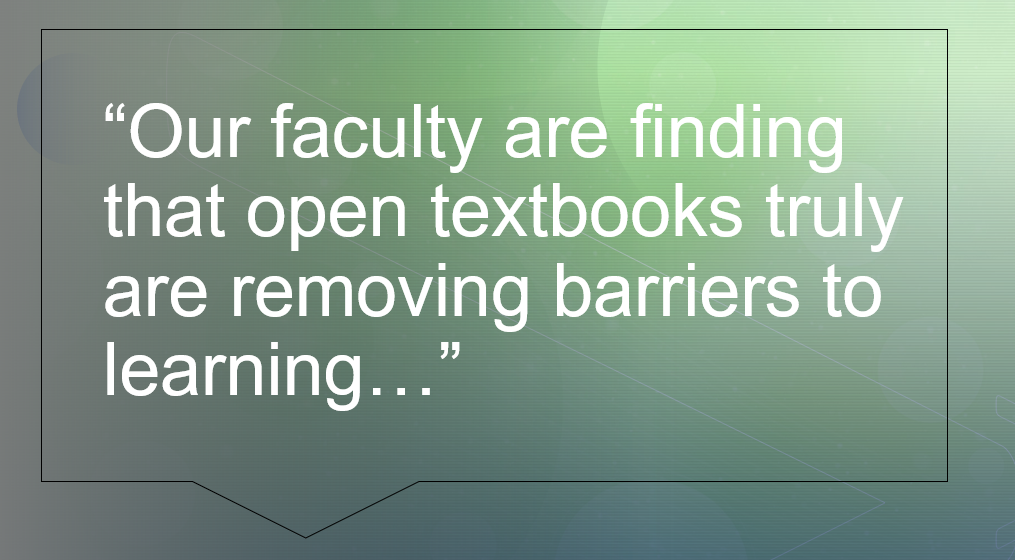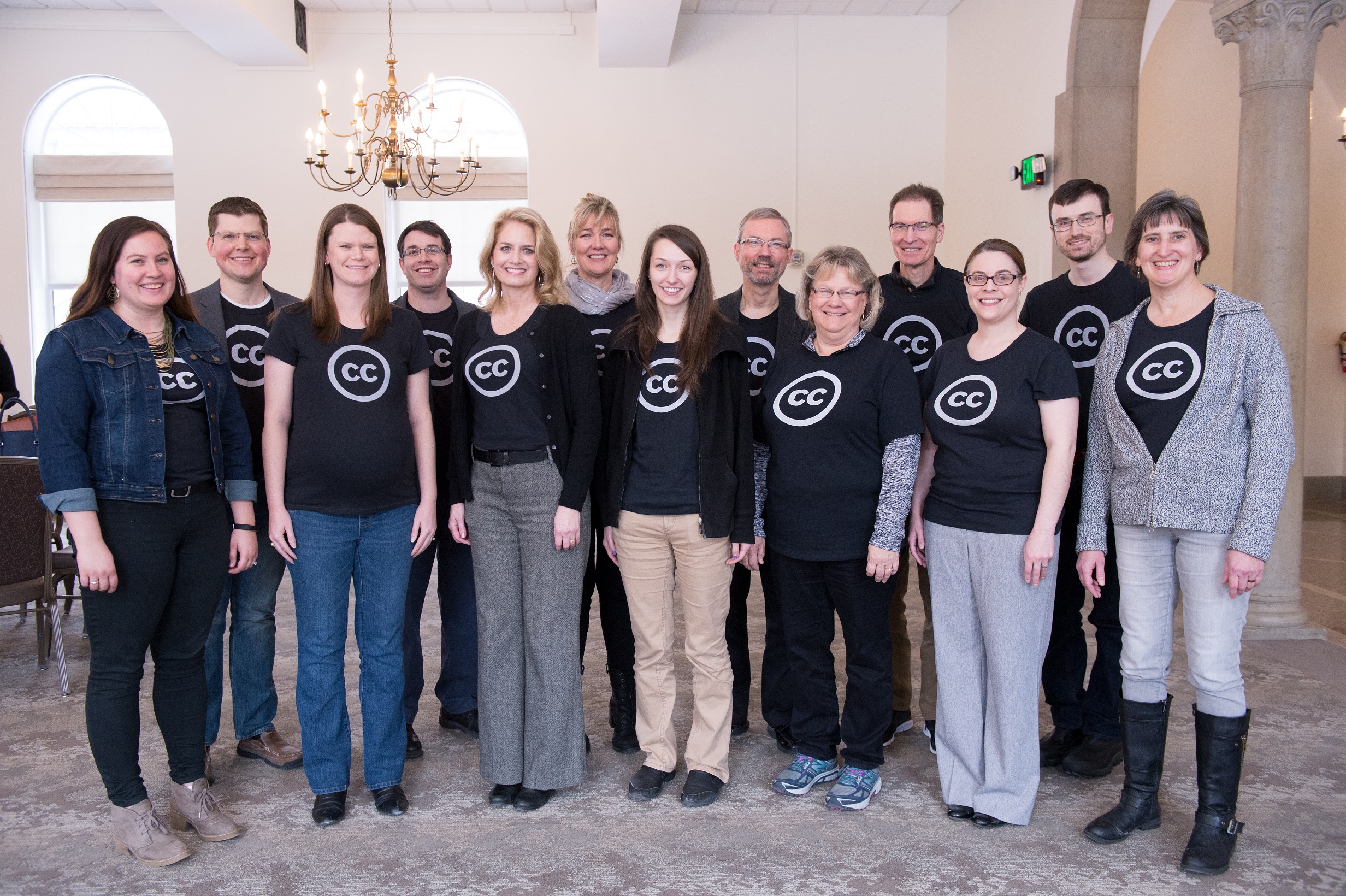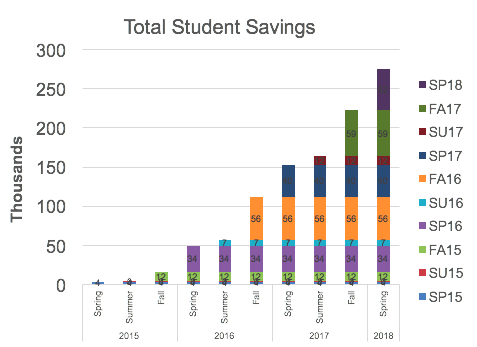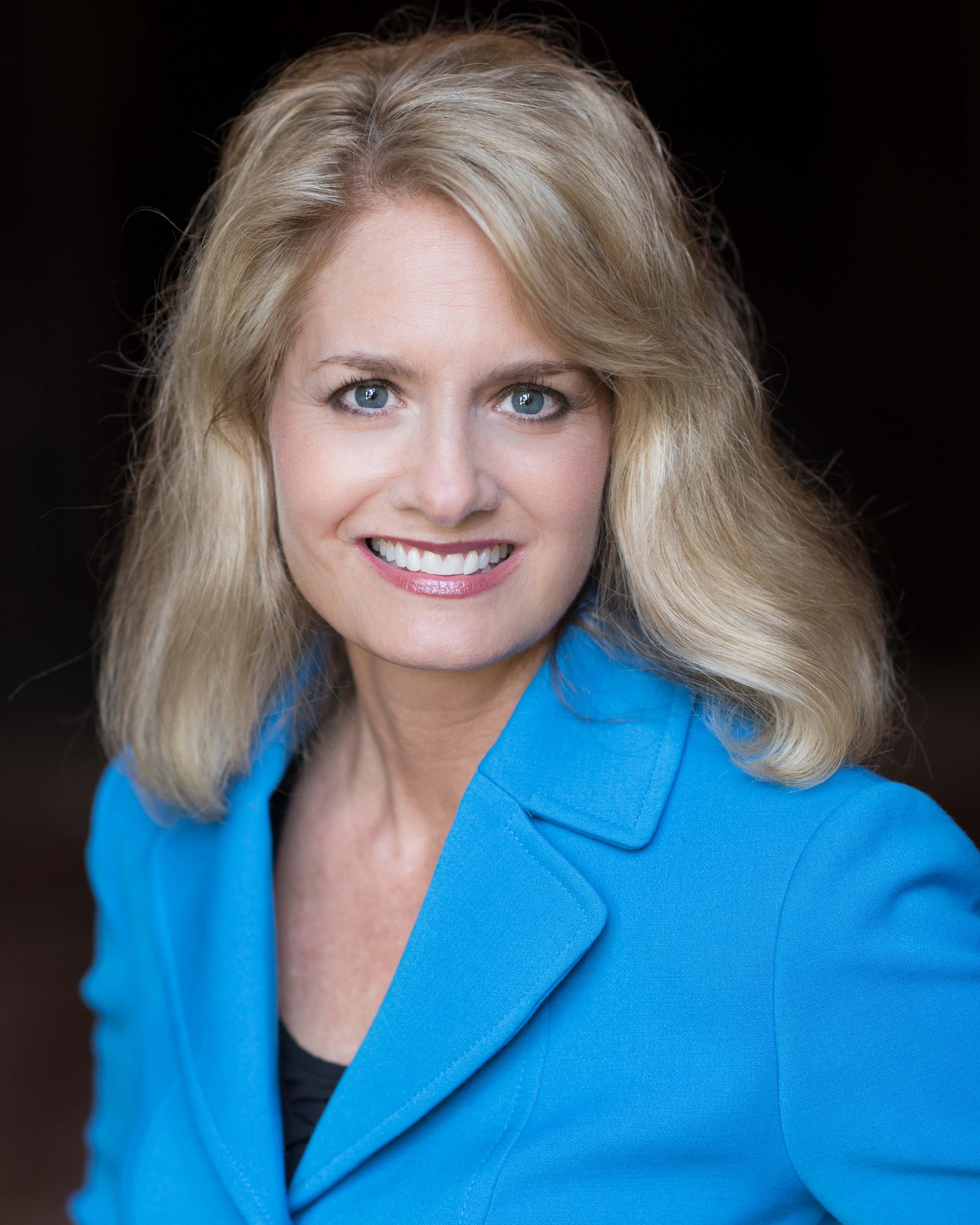Z Degrees (Zero-Textbook Cost Degrees) are what many consider the holy grail of Open Educational Resources (OER) accomplishments. Today’s guest blogger, Tanya Grosz, Ph. D., Dean of Graduate, Online & Adult Learning, led the open initiative at the University of Northwestern St. Paul—the first institution in Minnesota to create a Z Degree. Tanya and I met at an Open Textbook Network meeting in 2014, and we were happy to discover our similarities—English faculty, online learning geeks, interested in student achievement, and we have the same first name! I’m so proud of her leadership and success. Read all about Dr. Grosz’s journey from adopting her first open textbook to achieving a Z Degree through the implementation of more than 50 open textbook adoptions. Thank you Tanya for today’s post!
-Tanya Spilovoy, Director of Open Policy, WCET
It Started with a Question
 Back in 2011, as a keynote speaker for the MN eLearning Summit, Dr. Cable Green, Director of Open Education at Creative Commons (the legal licensing behind open educational resources), asked a question that stopped me in my tracks: “How are your students supposed to learn with books they can’t afford and are not buying?” As a long-time English teacher who was frequently frustrated about needing to buy yet another updated edition of a pricey literature anthology that had undergone only minor changes, the question resonated deeply with me. Green went on to offer a different way forward: learning resources licensed with a Creative Commons license, which enables them to be reused, revised, remixed, redistributed, and retained (The “Five R’s of Open” according to Lumen Learning’s David Wiley).
Back in 2011, as a keynote speaker for the MN eLearning Summit, Dr. Cable Green, Director of Open Education at Creative Commons (the legal licensing behind open educational resources), asked a question that stopped me in my tracks: “How are your students supposed to learn with books they can’t afford and are not buying?” As a long-time English teacher who was frequently frustrated about needing to buy yet another updated edition of a pricey literature anthology that had undergone only minor changes, the question resonated deeply with me. Green went on to offer a different way forward: learning resources licensed with a Creative Commons license, which enables them to be reused, revised, remixed, redistributed, and retained (The “Five R’s of Open” according to Lumen Learning’s David Wiley).
Shortly after hearing Green’s compelling question, I was introduced to Dr. David Ernst, the founder of the Open Textbook Network, the Open Textbook Library, and the Chief Information Officer for the College of Education and Human Development at the University of Minnesota, Twin Cities. He said he was on a grant from the Hewlett Foundation to promote the adoption of open textbooks through facilitated faculty workshops. When I asked if he would come to the University of Northwestern – St. Paul, a faith-based liberal arts university not far from where Ernst worked, he agreed. Northwestern soon became one of eight founding members of the Open Textbook Network, an alliance of now over 600 campuses dedicated to promoting access, affordability, and student success through the use of open textbooks.
A Shocking Financial Landscape
The financial landscape for students is fairly shocking: The average student owes approximately $30,000 in student loans. Funding for higher education keeps declining while tuition costs keep rising, and textbook prices have risen four times the rate of inflation. Mark Perry, Finance and Business Economics professor at the University of Michigan-Flint, suggests that college textbook prices have risen over 945% since 1978.
Sara Goldrick-Rab, in her book Paying the Price: College Costs, Financial Aid, and the Betrayal of the American Dream, provides an insightful critique of federal financial aid and the problems inherent with the outdated formula that determines institutional allocations. She demonstrates that the federal needs analysis which governs financial aid eligibility is hopelessly outdated because the financial situations of low-income students and their families are not accurately represented. These students often provide support to their families instead of the other way around. Furthermore, while tuition and fees are labeled “direct educational expenses,” everything else, such as food, rent, gas money, and textbooks, are labeled “indirect” and “noneducational.” Goldrick-Rab suggests that, “Paying tuition allows students to go to class, but they will fail if they have no books, no pencils, no gas money to get to school, and no food in their stomachs.”
The Exciting OER Solution
These and other financial realities were presented to University of Northwestern – St. Paul administration and faculty with one exciting solution: Open Educational Resources (OER). OER include any type of educational materials that are in the public domain or introduced with an open license. The nature of these open materials means that anyone can legally and freely copy, use, adapt and re-share them. Open textbooks are a specific type of OER—they are textbooks licensed under an open copyright license and made available online to be freely used by students, teachers and members of the public. Many open textbooks are distributed in either print, e-book, or audio formats that may be downloaded or purchased at little or no cost.
The Open Textbook Network (OTN) came to our campus twice and facilitated faculty workshops that provided an overview of the obstacles that high textbook prices present for students and how open textbooks offer a desirable alternative. They offered a $200 stipend for qualified faculty to review an open textbook in the Open Textbook Library. As the dean over online learning and our instructional design team, I was able to allocate instructional design support for faculty interesting in adopting or adapting an open textbook or curating open educational resources. If faculty would adopt OER, our instructional designers would support them from a technological standpoint, freeing the faculty member to be the Subject Matter Expert (SME) and not have to worry about the technology behind adopting or adapting. When a fellow dean and Chemistry professor announced our first open textbook adoption in fall 2015, the class spontaneously applauded after he told them there would be zero textbook costs for their Chemistry book that semester.
Northwestern’s Three-Pronged Approach
Northwestern’s open initiative wasn’t centered around open textbooks only. We developed a three-pronged strategy; first, we had to raise awareness about student debt and the current financial realities. Second, we wanted to partner well with our rock-star librarians to ensure that we were fully utilizing already-purchased library materials when designing and revising courses. Finally, we wanted faculty to be adopting (and adapting) open textbooks. The three-pronged approach made our open initiative more inclusive, and as a result, it gained traction fairly quickly. The support of our instructional design team, I later found out, is fairly unique. I believe it’s one of the reasons that our open initiative has been so successful; faculty members are more likely to adopt and adapt open textbooks when they have the technology support to do so. Also, as the instructional design team grew in their knowledge of OER and where to find them and I garnered valuable resources from the Open Textbook Network, we began reaching out more strategically and proactively to professors about available open textbooks when a course was due to be revised, new courses were being written, or when particularly interesting open textbooks became available.
In direct response to our growing open textbook initiative, our online course launch meetings evolved. When facilitating new course development, we now have the SME (professor), an instructional designer, and a librarian present to ensure that we are choosing the best possible resources for the course.  Our faculty are finding that open textbooks truly are removing barriers to learning, and they love the fact that the open textbook is available to students immediately students don’t have to wait for their paycheck or for financial aid to hit their accounts to access their texts. Our Online Learning Office (which houses our awesome instructional design team) has become the “home” of our open initiative, and they are building a web presence to support open adoptions.
Our faculty are finding that open textbooks truly are removing barriers to learning, and they love the fact that the open textbook is available to students immediately students don’t have to wait for their paycheck or for financial aid to hit their accounts to access their texts. Our Online Learning Office (which houses our awesome instructional design team) has become the “home” of our open initiative, and they are building a web presence to support open adoptions.
Adding the Student Voice
We knew that we were lacking student voices within our open initiative. Taking a cue from the Open Textbook Network, we created a video of our students talking about how high textbook prices had impacted them, and then panned to the Chemistry students talking about what they thought of their open Chemistry book. This spring, we added a video of faculty who have adopted open textbooks speaking about their perceptions of quality and student impact. Having students and faculty speak about open textbooks themselves is powerful, and it’s helpful to keep reminding our community about our open initiative. About the same time, the Student PIRGS came out with a compelling report about rising textbook costs, how those costs are negatively impacting students, and how open textbooks provide a solution in Covering the Cost: Why We Can No Longer Afford to Ignore High Textbook Prices, that I shared widely across our campus.
Minnesota’s Z Degree
Our Zero-cost Textbook Degree or Z degree, the first Z degree in Minnesota, arose quite naturally out of our growing open initiative; we learned about Tidewater Community College’s Z degree and asked, “Why couldn’t we create a Z degree?” We chose our adult undergraduate Business Management degree, had a supportive program manager collaborate with our SMEs and instructional designers, and then worked one by one through the core courses in the program to ensure there were high-quality OER available that met the objectives of each course, and when there weren’t, we looked to our library for resource support. Our open initiative has made the course design process more iterative, and I love the fact that our designers can help our professors “chunk out” resources throughout the course, placing digital chapters where they will be read within the course. The idea of openness has permeated our thinking about new projects; sharing has become our new normal. President of University of Northwestern – St. Paul Dr. Alan Cureton says, “Through the open textbook initiative, Dr. Grosz and her team have introduced an exciting innovation that benefits our students by making education more accessible and affordable. I’m proud of our Z degree, our many open textbook adoptions, and our faculty for embracing this significant educational movement toward openness.”
Concerns Surrounding Open Initiatives
Everything wasn’t always smooth sailing; certainly, there were skeptics. The two biggest concerns voiced by faculty were 1) the quality of open textbooks and 2) the curtailing of academic freedom.
The Open Textbook Network is clear in their coaching that it’s not my job to speak to the quality of open textbooks. Instead, I leave that to SMEs who review the open textbooks. I pointed skeptical faculty to the Open Textbook Library to review quality for themselves and shared a compelling study that demonstrates students in more than half of the courses using open textbooks did better according to at least one academic measure, and students in 93% of these courses did at least as well by all of the measures. Studies measuring the academic impact of open resources are proliferating, and they all point to the fact that students do the same or better as their peers using traditional textbooks.
Regarding academic freedom, I was able to speak as a faculty member and long-time teacher myself: I found it incredibly empowering that open textbooks allow me to actually augment and adapt content, thereby introducing a continuous improvement loop that certainly does not exist with traditional textbooks. In addition, it is ultimately the faculty member and academic department’s decision as to what course materials are chosen. Open textbooks provide faculty another choice, so as opposed to limiting academic freedom, I argue that they expand and augment it. However, just like any other disruptive innovation, I have welcomed the faculty who are eager to embrace open textbooks and then encouraged them to become champions of open, celebrating victories such as our 50th open textbook adoption during Open Education Week.
In addition to ensuring that I listened well to faculty concerns, I faced a campus bookstore that was understandably skeptical of the open textbook initiative, concerned about the potential loss of revenue. In retrospect, I wish that I had partnered with the bookstore prior to making any faculty presentations to help ensure understanding and support early on. David Wiley writes that campus bookstores actually don’t make very much on textbook sales, suggesting that they consider adding print-on-demand centers. At one OTN Summit, someone suggested open proponents invite their campus bookstore to the Textbook Affordability Conference. On some campuses, bookstores have partnered effectively with open proponents, and that remains my hope as well. Regular communication and sharing of positive student impact should help us make progress towards achieving that end. Regarding impact, since 2015, our open initiative has saved students $275,000, and if we maintain our current course of average adoptions per semester, we will have saved students approximately $742,000 through 2023. 
Sharing Success
The impact has been far more than just financial, however; I found that I had opportunities to talk about open textbooks and our success openly, such as on a local television morning show, at various presentations to local university libraries, through presentations with Dave Ernst at EDUCAUSE Learning Initiative’s Annual Meeting and the Higher Learning Commission Annual Conference, among others. I embraced and continue to say yes to these opportunities, not because they are in my job description or because I have time on my hands, but because I believe that open is a social justice issue. According to Jhangiani and DeRosa, “When faculty use OER, we aren’t just saving a student money on textbooks: we are directly impacting that student’s ability to enroll in, persist through, and successfully complete a course.” And my interest in open has blossomed into an interest in the myriad other obstacles facing college students, from childcare costs to food insecurity. As educators, we want to make a difference, and OER have provided me an opportunity to do just that—to tell other professors, librarians, and administrators that open increases access to learning. According to Dave Ernst, creator of the Open Textbook Network, “The University of Northwestern St. Paul’s open textbook program is a great example of the impact an institution can make when they are persistent, strategic, and supportive of their faculty.”
Here’s to The Future
Where we go from here is an interesting question. Certainly, we want more Z degrees. And I’m planning to co-fund the writing and publication of our first open textbook with our library during the 2018-2019 academic year. But even more compelling, I believe, is the idea of moving toward open pedagogy so that our students can be empowered as participants in the construction of knowledge along with their professors. Becoming open content producers and curators themselves will engage our students even more fully in an active learning environment re-envisioned to be innately more impactful. DeRosa and Robison suggest that, “When we think about OER as something we do rather than something we find/adopt/acquire, we begin to tap their full potential for learning.” Slowly but surely, we are embracing an educational future that reduces barriers and increases access to learners; with OER, we are opening up new pathways to success.

Tanya Grosz
Dean, College of Graduate, Online & Adult Learning
Assistant Professor of English
University of Northwestern St. Paul

 Back in 2011, as a keynote speaker for the MN eLearning Summit, Dr.
Back in 2011, as a keynote speaker for the MN eLearning Summit, Dr.  Our faculty are finding that open textbooks truly are removing barriers to learning, and they love the fact that the open textbook is available to students immediately students don’t have to wait for their paycheck or for financial aid to hit their accounts to access their texts. Our Online Learning Office (which houses our awesome instructional design team) has become the “home” of our open initiative, and they are building a
Our faculty are finding that open textbooks truly are removing barriers to learning, and they love the fact that the open textbook is available to students immediately students don’t have to wait for their paycheck or for financial aid to hit their accounts to access their texts. Our Online Learning Office (which houses our awesome instructional design team) has become the “home” of our open initiative, and they are building a 



1 reply on “Opening a New Path to Success – A Journey with Open Textbooks”
[…] a New Path to Success – A Journey with Open Textbooks https://wcet.wiche.testing.brossgroup.com/frontiers/2018/04/26/opening-a-new-path-to-success-a-journey-with-open-textbooks/&nb… via @wcet_info Removing barriers and reducing costs students – OER have so much potential. […]